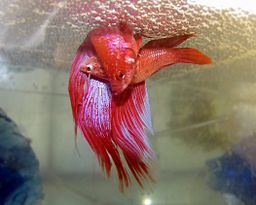How to Breed Betta Fish?
Do you want to learn how to breed betta fish? Well, breeding these fish species is all about creating the perfect environment for the male and the female so that they can mate successfully.

Here are some of the most essential extra equipment you'll require to get started even on a smaller scale.
- 2 Betta fishes, male and female.
- A 10 gallon fish tank. (minimum)
- 25W aquarium water heater
- Air pump and water filter
- Aquatic plants. Recommended species is Indian almond leaf
- Simple decorating ornaments to hold the aquatic plant in place
- A glass jar that will fit in the 10 gallon tank.
- Fish net
With this minimum equipment you can get started with spawning.
- The first step is to set up the breeding tank properly. You don?t have to fill up the entire height of the tank. This tank will have the above mentioned aquatic plants. You may have some decorative stone at the bottom so that the plant will stay in one place. This plant will help as a hiding place for the female betta once breeding is done and she has finished laying eggs. Keep the glass jar filled with the same water in the tank. So you have a tank fill with water and the jar filled with the same water inside the water. This creates two distinct compartments for the male and the female. This tank will also have a water heater set up to 80 degrees Fahrenheit. Since the water level is not of the full height you can tilt the heater and sump it inside the tank. The air pump and the sponge water filer will also be placed in the corner. So just like your main tank, breeding tank will require this extra set up so that male and female can mate safely.
- Picking up the male and the female betta fish is important here. Fish that are approximately 6 to 12 months old are in good health for mating and reproducing babies. If male and female are of the same color, then it is more likely that the babies will be of same color.
- In the above setup release the female betta in the jar and release the male beta in the tank outside of the jar. This will allow the male betta to see the female but can't mate with her. During this time make sure you feed your fish well with live food
- As the male will see the female but can't touch her he will start making circles around the jar and will start flaring. When this is done enough, the male will form a bubble nest for the eggs that will float on water surface at the top. When forming the nest is complete, release the female from the jar into the outside tank.
- The male and the female will start fighting and biting each other. The female will regularly check if the bubble nest is ready or not. Once she notices that it's ready, she will rub her body against the male fish. While actual mating, the male and the female will squeeze their bodies together. Once the squeezing is finished the female will release eggs.
- The male fish will carry the eggs and insert them into the bubble nest by carrying them in his mouth. This process goes on for many hours. Even squeezing may happen more than once. Once mating is done the female will go and hide herself in the plants. This is the right time to take her out and put her in another tank with no other fish. The male will continue to collect the eggs and insert them into the bubble nest. During this time do not feed him
- After 24 hours the eggs will start to hatch and you'll see small string like things coming out of the eggs. The fry will start falling from the eggs down and the male fish will collect them and insert them into the nest again. After 2 days the fry will start swimming independently along the surface of the tank. At this point you can remove the male fish from the tank and keep him in another tank. As sometimes it's possible that the male fish will start eating the fry itself.
Contact | Privacy Policy | Sitemap | |